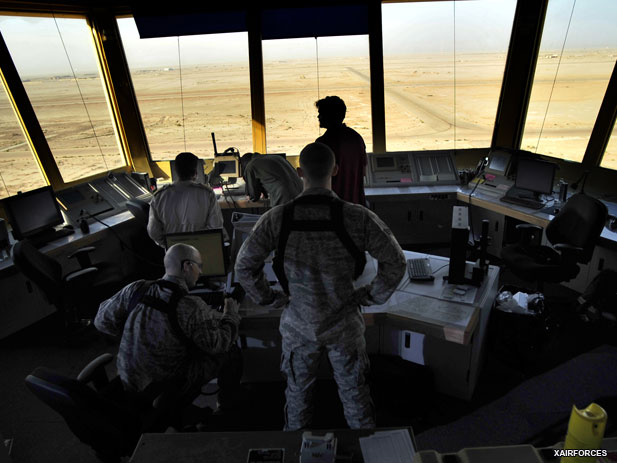
New Radar paints Iraq's air defense picture

As U.S. forces redeploy from Iraq, areas of responsibility are being transferred to the Iraqi security forces. Contingency Operating Base Adder will become Imam Ali Air Base, an Iraqi air force installation dedicated to securing the skies over the southern provinces.
The Iraqi air force wing taking command of the installation will have a new tool to make that mission possible: a state-of-the-art radar facility. The $55 million facility was constructed by a joint effort of contractors with Lockheed Martin and the U.S. Army Corps of Engineers, and sold by the U.S. to Iraq in a foreign military sales case. [Terry Hoke, an instructor with Lockheed Martin, gives a presentation to Iraqi air force officers on Contingency Operating Base Adder, Nov. 1. Iraqi personnel were given classes in communications networks, ground transmission, and radar theory.] “The objective of the system is to provide them a single point location where they can monitor the entire airspace over their country,” said Scott Hosking, technical director with Lockheed Martin. “This system will integrate the air traffic control radars that are scattered throughout the country as well as the long range radars we are putting in as a part of this effort.”
The project started in late 2009, and is the culmination of efforts by U.S. forces, civilian contractors, and the Iraqi air force, said Hosking, who trained Iraqi air force personnel on use of the radar technology. The project entered its final stage this September when Iraqis began their training to operate the system, he added.
“Now that the radar is up and running, they are able to use the computers to do their aerodefense mission,” said Tech. Sgt. Denise Wright, “Because of the communications capability that is set up, Baghdad is also able to receive transmissions of what they are seeing here.”
“They will have their own network, as we are familiar with the terminology of DSN, Defense Switch Network, they have the IDN, Iraqi Defense Network,” said Wright. “They can work together with Baghdad; they are able to communicate with each other.”The Iraqis needed training and preparation to take on the task of using the radar and the defense network, said Wright. They did not always have the capabilities they do now.
“Since early September, we have been conducting training on this system to the Iraqis,” said Hosking. “A little bit more hands on, and a little bit more one-on-one type interaction has brought them a long ways, and I think they will be very proficient and should be able to step right into the role.”
Participation of U.S. service members made the project possible, said Hosking. “They’ve been providing an awful lot of support logistically and getting through the hurdles of operation on a coalition base like this,” he said. “They have opened the doors we needed opened.”
“The language barrier, that was our biggest hurdle,” said Master Sgt. Marcus Williams, ITAM supply advisor. With help from interpreters and English-speaking Iraqi air force officers, the joint force was able to handle that challenge, said Williams, who interacted with the Iraqis on a daily basis, and acted as the liaison for civilian contractors and U.S. troops.
“At the beginning it was rough; but the difficulties we were able to overcome, and once all their training is completed, there is no doubt in my mind they can take over the [sector operations center] and do an effective job,” said Williams.
U.S. forces are departing Iraq to meet the deadline set by the Status of Forces Agreement signed between the two countries in 2008. When American troops leave, installations like COB Adder will belong to Iraqi security forces.
With the training and tools in hand, the Iraqi air force are more prepared than ever to take on the role of defending Iraqi airspace.
Source: 3 November 2011 - Written by Pvt. Andrew Slovensky, 362nd Mobile Public Affairs Detachment Thursday, November - http://www.usf-iraq.com
Washington announces close handing of 2 highly-developed Radars for Iraq
Washington has announced its close decision to hand over for Iraq 2 developed Radar sets to complete its Air Defense System, according to al-Hayat Newspaper on Sunday.
"The United States shall hand over Iraq 2 Radars, that will be able to cover the largest area of the country," al-Hayat quoted the Spokesman for the US Army in Iraq, General Jeffery Bucanon (Ed: verbatim), as saying.
The US General has reiterated that Iraqis will be able to control the Iraqi airspace after the US troops withdrawal from the country, whilst the 2 Radars would be accompanied by American trainers from their producing company to train the Iraqis to operate them.
"Our relationship with the Iraqi Naval Force shall continue for a long time and we shall train its fleets, existing in the Arab Gulf and Bahrain," he said.
The Agreement, signed between Iraq and Washington in 2008, envisages that the US forces would withdraw from Iraq by the end of December next.
Source: 13 October 2011 - Aswat Al Iraq / Politics, Baghdad - SKH (PT) - http://en.aswataliraq.info
Photo: Air traffic controllers - Tech. Sgt. Bryce Hamilton and Senior Airman Matt Morrow, 407th Air Expeditionary Group air traffic controllers, along with Iraqi counterparts and a U.S. contractor control the air space above Ali Base, Iraq. As Operation New Dawn continues to progress, U.S. Air Force air traffic controllers at Ali Base are working side-by-side with U.S. civilian controllers and Iraqi airmen to transition the airspace back to Iraq. Hamilton is deployed from Offutt Air Force Base, Neb., and is from Charlotte, Iowa. Morrow is deployed from Barksdale Air Force Base, La., and is from Cabot, Ark. (U.S. Air Force photo/Master Sgt. Cecilio Ricardo)
(13.11.2011)
|